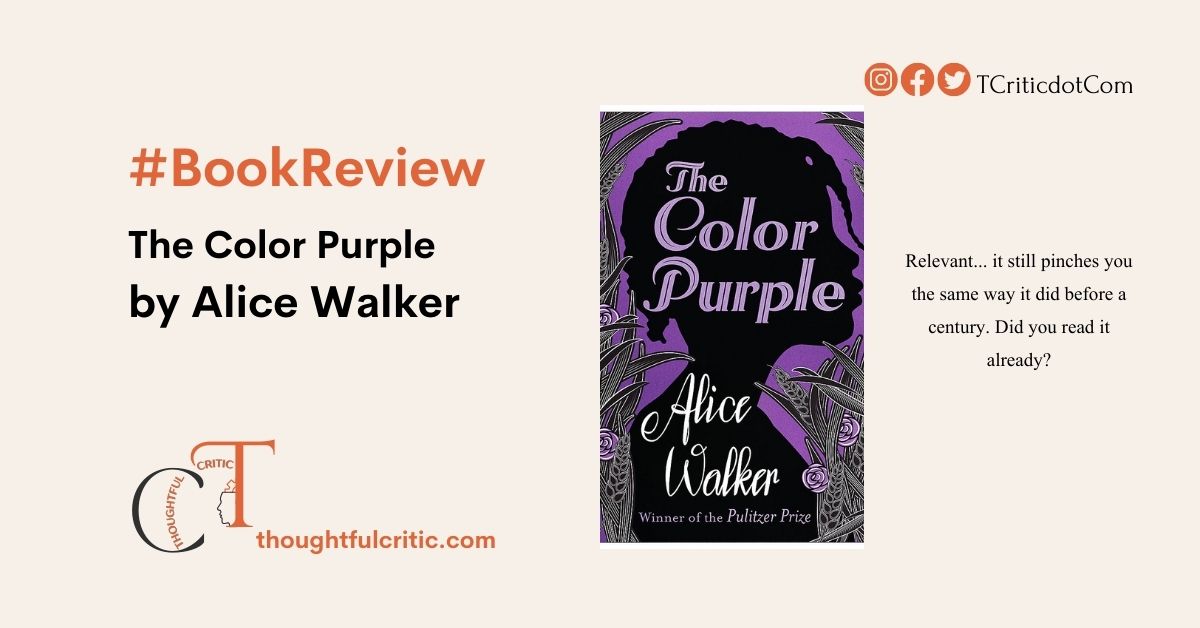Alice Walker’s “The Color Purple,” published in 1982, stands as a cornerstone of American literature. The novel, which won the Pulitzer Prize for Fiction and the National Book Award, is lauded for its vivid depiction of African American women’s struggles and resilience in the early 20th-century American South. It has been celebrated for its unflinching portrayal of personal and societal challenges while also sparking significant debate and criticism.
A Glimpse of the Storyline:
The novel unfolds through the letters of Celie, a young African American girl who initially writes to God, later addressing her letters to her sister, Nettie. Celie’s life is marked by severe abuse at the hands of her father and husband, Albert (referred to as “Mister”). Readers witness Celie’s painful journey from oppression to self-empowerment through her correspondence, aided by the strong female characters she encounters, such as the independent and free-spirited singer Shug Avery. Nettie’s letters from Africa provide a parallel narrative that enriches the main storyline, revealing the broader implications of colonialism and cultural identity.
Critical Evaluation of the Plot:
The plot of “The Color Purple” is compelling and poignant, driven by Celie’s personal growth and the transformative power of female solidarity. The epistolary format creates an intimate and direct connection with Celie, immersing readers in her emotional and psychological landscape. However, the narrative sometimes has uneven pacing, with certain plot developments feeling rushed, particularly towards the conclusion. The resolution of character arcs, especially the reconciliations, can appear overly idealistic given the severe nature of past abuses.
Critical Evaluation of the Narrative Structure:
The novel’s epistolary structure is one of its most distinctive features, providing a raw and unfiltered look into Celie’s innermost thoughts and feelings. This format fosters an intimate connection between Celie and the reader, enhancing the emotional impact of her story. Using letters also allows for diverse voices and perspectives, mainly through Nettie’s correspondence, which adds depth and complexity to the narrative. However, this structure can sometimes lead to disjointedness, with abrupt shifts in time and perspective that may disrupt the flow of the story. Additionally, relying on letters as the primary narrative device may limit the exploration of specific scenes and interactions, as they are filtered through the characters’ reflections rather than direct exposition.
Critical Observations on the Themes:
“The Color Purple” is a beautifully crafted novel that delves deeply into the complex themes of racism, sexism, and the search for individual identity. Through a vivid portrayal of systemic oppression faced by African American women, the novel provokes powerful and thought-provoking reflections. One of its central themes is the emergence of female solidarity, demonstrating the profound strength and resilience women derive from their mutual relationships. However, some criticisms have surfaced regarding the novel’s portrayal of male characters, with concerns about the reinforcement of negative stereotypes through the depiction of many male characters as abusive and oppressive. This has ignited debate regarding the evenhandedness and fairness in the representation of characters within the novel.
What worked the best (overall)?
The novel’s greatest strengths are its emotional impact and depth of character development. Celie’s transformation from a submissive, abused girl to an empowered, independent woman is both inspiring and compelling. Walker’s use of vernacular language and the epistolary format add authenticity and intimacy to the narrative, creating a unique and engaging reading experience. Exploring profound themes such as personal and spiritual growth and the importance of female solidarity provides a rich and layered reading experience.
What didn’t work out well (overall)?
The graphic depictions of sexual abuse and violence in the story are portrayed in a way that is integral to the plot. Still, it’s important to note that these scenes may be distressing and overwhelming for some readers due to their explicit nature. Additionally, the portrayal of male characters as predominantly negative has been criticised for potentially reinforcing harmful stereotypes. It’s worth considering that some readers may find this story aspect troubling.
In addition, the occasional oversimplification of complex social issues within the plot and the narrative’s uneven pacing detract from the story’s overall coherence and impact. This might make it more challenging for some readers to engage with the narrative entirely.
The Color Purple and the American Literature:
“The Color Purple” is crucial in American literature for its pioneering representation of African American women’s voices, exploring the intersectionality of race, gender, and class. Through its innovative epistolary format and vernacular language, the novel captures the authentic experiences of its characters, highlighting themes of resilience and empowerment. Its impact extends beyond the literary world, influencing feminist and civil rights movements by addressing systemic oppression and advocating for social justice. The novel’s cultural significance is further amplified by successful adaptations into film and Broadway, making its powerful narrative widely accessible. RecognizedRecognisedtigious awards, including the Pulitzer Prize and the National Book Award, “The Color Purple” remains a transformative work that continues to shape literary expression and cultural discourse.
Ideal audience of this novel:
“The Color Purple” best suits readers interested in deep, character-driven narratives tackling significant social issues. It appeals to those who appreciate literature that addresses the intersections of race, gender, and identity. Due to its graphic content and intense themes may be more suitable for mature readers who can engage with its challenging subject matter.
Conclusion
Alice Walker’s “The Color Purple” is a seminal work that explores African American women’s experiences in the early 20th century. While its emotional depth, compelling character development, and profound themes make it a significant and enduring piece of literature, the novel has flaws. The graphic content, portrayal of male characters, and occasional narrative inconsistencies warrant critical examination. Nevertheless, “The Color Purple” remains essential for portraying resilience, empowerment, and the transformative power of female solidarity.
Click here to get a copy from Amazon India
Review by Anand for Thoughtful Critics
The Color Purple by Alice Walker Book Review
-
Thoughtful Critic's Rating
Summary
It’s relevant. It still pinches you the same way it did a century ago. Have you read it already?




